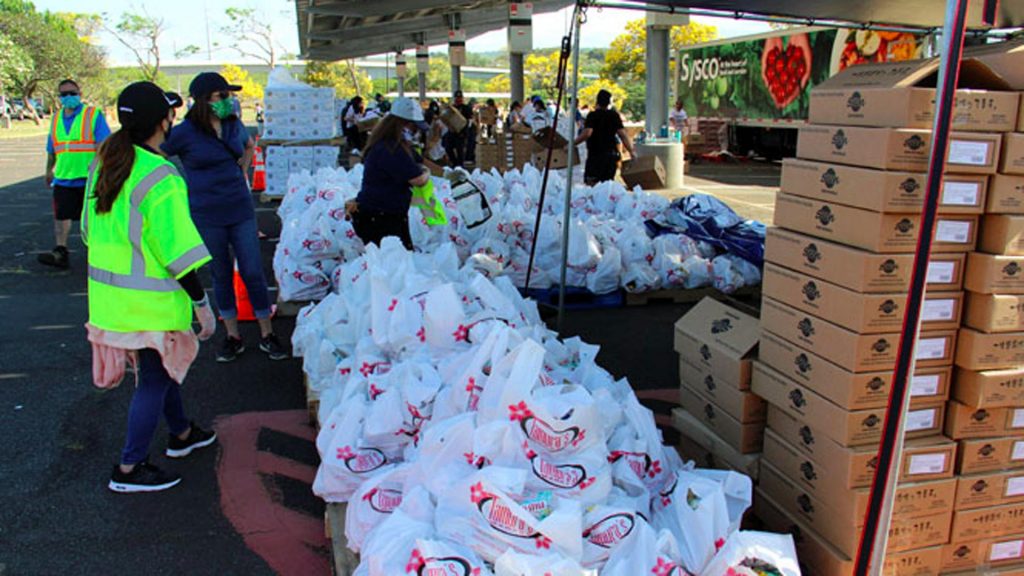UH Study Finds 48 Percent of Hawaiʻi Families with Children Report Food Insecurity
A team of researchers at the University of Hawaiʻi at Mānoa’s College of Social Sciences led a study on food insecurity for Hawaiʻi families with children. The report showed that 48 perdcent of families with children in the state are experiencing food insecurity, with 76 percent of families reporting that they had lost employment income due to COVID-19.

Recent developments, trends and how to address food insecurity for Hawaiʻi families with children is the subject of a recent study led by a team of researchers at the UH Mānoa’s College of Social Sciences as part of its Health Policy Initiative. According to the “Addressing Hunger and Food Insecurity among Hawaiʻi’s Families” report, sustained intervention and system-level changes will be key.
Food insecure households are defined as those lacking enough food for an active, healthy life for all household members. The UH study finds that 48 percent of Hawaiʻi families with children are experiencing food insecurity, with 15% reporting that they did not have enough food in the past week.
These impacts have been greater for low-income families, those with less formal education, certain racial/ethnic groups and families who live in rural areas. About 76 percent of families who had reported very low food security had lost employment income due to COVID-19.
UH‘s “Addressing Hunger and Food Insecurity among Hawaiʻi’s Families,” analyzed Pulse surveys by the US Census Bureau, with a sample of 700-900 people in the state every two weeks; interviews with local stakeholders; and archival data from the Hawaiʻi Department of Human Services.
Six primary barriers to accessing services and food security were identified. They are:
- A lack of public awareness of available services.
- The stigma and embarrassment associated with needing assistance.
- The differing needs and contexts by impacted families, resulting in an ineffective one-size-fits-all approach to services.
- Transportation barriers.
- Housing insecurity.
- The lack of a coordinated statewide plan for addressing food insecurity.
The report acknowledges that local efforts have increased to address these issues through benefits programs such as Supplemental Nutrition Assistance Program or Electronic Benefits Transfer; prepared meals programs that include free or reduced-price school meals; and emergency solutions including food banks and food distributions. However, despite this expansion of services, data suggest that many food-insecure families are still in need.
“Efforts addressing food insecurity have been greatly expanded since last March, yet the need is still increasing,” said Anna Pruitt in the Department of Psychology. “Great and effective work is being done, but it’s not enough and that is concerning.”
The researchers’ suggested recommendations include:
- Developing more tailored approaches to food insecurity and needs. For example, families living unsheltered or in unstable housing may need access to shelf food and delivery of prepared meals; rural families may require transportation assistance or delivery services; and hard-to-reach populations and areas may benefit from mobile outreach to families in unstable housing situations.
- Addressing housing insecurity and transportation barriers. With the recognition of an overlap between food and housing insecurity, food insecurity cannot be solved without also addressing housing insecurity and homelessness. In addition to difficulties storing food, housing insecure families may struggle to secure benefits for which they qualify. In addition, since transportation was an issue for many families experiencing food insecurity, more widespread outreach and service delivery programs are required.
- Enhancing long-term, s ystems-level solutions and community-based approaches. Communities have existing strengths on which to build, such as community-based food systems creating regional markets that shorten the distance between consumer and farmer. For example, the Double Up Food Bucks program, which doubles the value of SNAP benefits, could be enhanced since it benefits both SNAP recipients and local farmers affected by the pandemic.
- Considering more flexibility and adaptations in policies. Given that more people are in need than are receiving services, long-held practices should be reviewed. For example, in-person interviews have long been cited as a barrier to accessing SNAP benefits for families with childcare and transportation challenges. Policies should be evaluated based on current needs and not necessarily held to historical practice.
The full 17-page report also includes specific recommendations for policymakers and programs/service systems.










